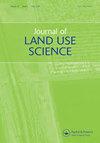More than surface temperature: mitigating thermal exposure in hyper-local land system
IF 3.3
4区 环境科学与生态学
Q1 AGRICULTURE, MULTIDISCIPLINARY
引用次数: 16
Abstract
ABSTRACT Regional land surface temperature (LST) maps derived from remote sensing data are most available to cities to assess and respond to heat. Yet, LST only captures one dimension of urban climate. This study investigates the extent to which remote sensing derived estimates of LST are a proxy for multiple climate variables at hyper-local scales (<10s of meters). We compare remotely sensed estimates of LST (RS-LST) to field and simulated LST, MRT, and air temperature (AT), in a neighborhood in Tucson, Arizona, USA. We find that LST, MRT, and ST follow different diurnal trends masked by RS-LST. We also find that three-dimensional urban design is a better predictor of MRT than two-dimensional land cover and albedo – a known determinant of RS-LST. Shade is a better predictor of both simulated LST and MRT than RS-LST. We conclude that RS-LST is not adequate for guiding heat mitigation at hyper-local scales in cities.超过地表温度:减轻超局部土地系统的热暴露
摘要:从遥感数据中获得的区域地表温度图最适合城市评估和应对高温。然而,LST只捕捉到了城市气候的一个维度。这项研究调查了遥感得出的LST估计在多大程度上代表了超局部尺度(<10米)的多个气候变量。在美国亚利桑那州图森市的一个社区,我们将遥感的LST(RS-LST)估计值与现场和模拟的LST、MRT和气温(AT)进行了比较。我们还发现,三维城市设计比二维土地覆盖和反照率(RS-LST的已知决定因素)更能预测MRT。阴影比RS-LST更能预测模拟LST和MRT。我们得出的结论是,RS-LST不足以指导城市超局部尺度的热量缓解。
本文章由计算机程序翻译,如有差异,请以英文原文为准。
求助全文
约1分钟内获得全文
求助全文
来源期刊

Journal of Land Use Science
Environmental Science-Management, Monitoring, Policy and Law
CiteScore
5.40
自引率
6.20%
发文量
26
期刊介绍:
The Journal of Land Use Science provides a central outlet for high-quality articles on theoretical and empirical aspects of land-use science at the interface of social and environmental systems. The Journal brings together an array of research perspectives at multiple temporal, spatial and social scales that contribute a better understanding of land-system dynamics and communicate scientific advances towards attaining land-system sustainability.
 求助内容:
求助内容: 应助结果提醒方式:
应助结果提醒方式:


